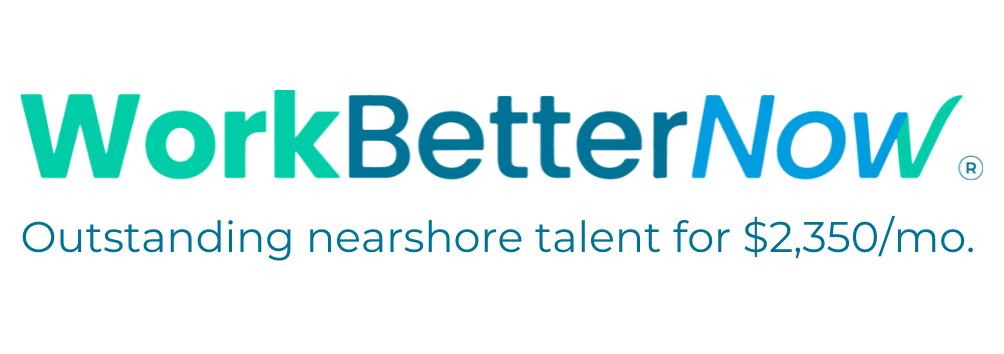At WorkBetterNow, we’re constantly finding new ways to empower our clients and remote professionals (RPs) with cutting-edge tools and technologies. With the potential of AI becoming increasingly apparent, we knew we had to jump into action and figure out how we could best use it to our advantage.
Our culture is built on learning, understanding and growing, so the obvious approach for us was to conduct a series of experiments. You may have seen our blog on how we integrated AI into our marketing department, and the results were thought-provoking, so we decided to tackle our recruiting department next.
We hope our discoveries will help guide you in some of the ways that AI can help your own recruiting efforts. Let’s dive in!
Experiment 1: Analyzing Employment Data
Our first thought was that AI could really help us improve our recruitment and retention strategies, so we gave the Data Insight Analyst GPT a try. Our ultimate goal with this experiment was to gain deeper insights into our employment trends, understand why employees were leaving, and find ways to boost retention and satisfaction.


The image provided does not contain actual data; the numbers were utilized solely for simulation purposes.
The process was straightforward yet incredibly insightful. The GPT sifted through mountains of data, looking at everything from employment durations to turnover rates and reasons for job terminations, identifying trends and patterns that we might have overlooked. It provided us with clarity into why employees were leaving and what could make their work experience better. retention.


The image provided does not contain actual data; the numbers were utilized solely for simulation purposes.
The impact was immediate and significant. We saw improvements in our staffing strategies, a reduction in turnover rates, and a renewed sense of confidence in our decision-making processes. With this technology, we’ve positioned ourselves as leaders in innovative HR practices, especially in the remote staffing sector for Latin America and the Caribbean. And we’re just getting started!
If you’d like to try this out for your business, you can replicate our experiment by first identifying areas within your operations where you could benefit from deeper insights and improvements. Whether it’s recruitment, retention, or another aspect of HR, pinpointing specific goals is key. Next, explore AI tools like the Data Insight Analyst GPT, which can analyze vast amounts of data to uncover trends and patterns that might otherwise go unnoticed. By inputting relevant data points and questions, you can gain valuable insights into employee behavior, turnover rates, and factors impacting job satisfaction. These insights can then inform strategic decisions and adjustments to HR practices, ultimately leading to improved outcomes and a more competitive edge in the market.
Experiment 2: Measuring Our Data with AI
With leads, interviews, and industry trends to analyze, we needed a solution that would allow us to consolidate and measure our data without hopping between different platforms. So for our next experiment, we tested out how Chat GPT –4 and Excel Integration for Data Analysis could possibly analyze industry trends to enhance and optimize our recruitment processes.

The process was a learning curve, to say the least. We downloaded the GPT plugin, set up an API key from OpenAI, and dove into learning the necessary formulas to make it all work. But as with any new technology, there were hiccups along the way. In the initial phase of analysis, we encountered some inaccuracies in the responses generated by the connection of two different AI platforms.
However, with some fine-tuning and perseverance, we finally found ourselves generating accurate responses and gaining valuable insights into our recruiting data, and we learned that data analysis doesn’t have to be daunting. With AI and language models like GPT, we were able to easily make data-driven decisions to drive better outcomes for our team, our RPs, and our clients.
If you’re seeking to enhance recruitment processes, you can follow a similar path by first identifying the challenges you face in consolidating and analyzing recruitment data. With a clear understanding of your goals, explore tools like Chat GPT –4 and Excel Integration for Data Analysis to streamline and optimize their data analysis processes. By downloading the necessary plugins and setting up API keys, you can begin experimenting with these tools to generate insights into industry trends and candidate responses. While there may be initial hurdles and inaccuracies to overcome, perseverance and fine-tuning can lead to accurate responses and valuable insights. Ultimately, embracing AI and language models empowers business owners to make data-driven decisions that drive better outcomes for their team, resource providers, and clients alike.
Experiment 3: Improving Our Interviewing & Hiring Process
Another significant problem we thought AI could help us with was spending too much time taking notes during interviews, leaving us with limited bandwidth to truly connect with candidates. We knew there had to be a better way—a solution that would allow us to conduct engaging interviews while still capturing all the important information.

We experimented with Honeit AI-Software, hoping it could turn our interview process into a more natural conversation, since our interviewers no longer needed to be focused on recording data and could stay in-the-moment. Candidates scheduled interviews through Honeit, and we connected to the platform to conduct the interviews. As candidates responded to our questions, we highlighted their answers, confident that the software was capturing every detail.
The outcomes were game-changing. Honeit recorded each interview, providing us with a transcript that we could review and edit for accuracy. With the AI-generated transcript in hand, we could create a comprehensive call summary, detailing the candidate’s experience, salary expectations, technical skills, and more.

By focusing on meaningful conversations instead of note-taking, we saved valuable time and got a better understanding of each candidate’s personality. We also discovered that Honeit’s AI feature could significantly reduce our hiring time by condensing the number of interviews needed from three to two as well as improving the screening process. Additionally, the AI feature created interview call guidelines based on the job description.
If you’re interested in experimenting with Honeit AI-Software or similar tools, you can start by researching and familiarizing yourself with the platform’s features and functionalities. You can then sign up for a trial or demo version to explore its capabilities firsthand. During this experimentation phase, you should identify specific interview processes or pain points they wish to address and determine how Honeit can alleviate those challenges.
Once you have a clear understanding of your objectives, you can begin using Honeit for conducting interviews. Schedule interviews with candidates through the platform and conduct the interviews as they normally would, but with the added benefit of Honeit recording and transcribing the conversations.
After completing the interviews, review the transcripts generated by Honeit to assess the accuracy and completeness of the information captured. You can experiment with creating call summaries or analyzing the data to gain insights into candidates’ qualifications, experiences, and personalities. Throughout the experimentation process, gather feedback from interviewers and candidates to evaluate the effectiveness of Honeit in improving the interview experience and streamlining the hiring process. Based on this feedback, you can adjust your approach and continue refining their use of the platform to achieve optimal results.
Into the Future with WBN and AI
Looking ahead, we’re excited to continue experimenting with different AI technologies to see how they can enhance our recruitment capabilities. With each experiment, we’re not only learning and adapting but also setting the stage for future advancements. Stay tuned to see how we’re exploring AI in other WBN departments!
Ready to upgrade your recruitment process with AI-powered solutions? Sign up for a free 15-minute consultation with our expert team to discover how WorkBetterNow can help.
Share it on social media
Related articles
Discovering Top Performers Where You Least Expect Them
The Unlimited Potential of WBN ProfessionalsFinding great talent these days…
What’s Next: Continuous Learning in AI
When ChatGPT rolled out in January 2023, it showcased to…
Critical practices you cannot overlook when managing remote talent
Having been a 100% remote company since Day One, and…
WorkBetterNow’s Initial AI Journey: Recruiting Department
At WorkBetterNow, we're constantly finding new ways to empower our…
WorkBetterNow’s Initial AI Journey: IT Department
With the transformative potential of AI becoming increasingly evident for…
How WorkBetterNow’s Adoption of EOS Fuels Rapid Growth with Seamless Management
If you’re like me and my partner, you’re always looking…







